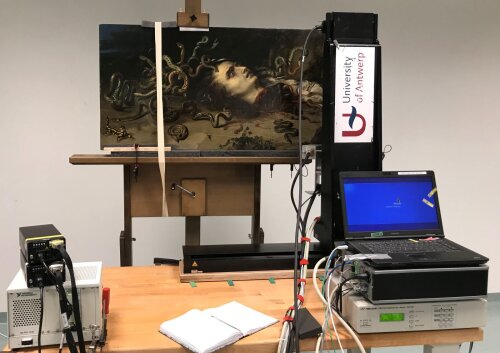The rich collection of the Kunsthistorisches Museum (KHM) in Vienna includes an extensive corpus of paintings by Peter Paul Rubens, among which a number of the key works in the oeuvre of this Flemish artist. One of them is 'Het Pelsken', which is also discussed on this website. The KHM exhibition Rubens: The Power of Transformation showed the creative processes of Rubens and analysed how he transformed his sources (KHM, Vienna, 17 October 2017 - 21 January 2018).
Head of the Medusa is one of Rubens’ highly innovative compositions, in which he challenges innovations of Leonardo and Caravaggio. It was created around 1618, when Rubens established his famous atelier at De Wapper (currently Museum Rubenshuis). However, a second high quality version of this painting is in the collection of Moravian Gallery in Brno. The latter version is slightly smaller in size and is painted on panel. The fact that both paintings are preserved creates a unique opportunity for up-close, vis-à-vis study. However, until now, the two paintings have never been directly compared.

A technical comparison of the version in the Kunsthistorisches Museum in Vienna and the version in the Moravian Gallery in Brno is of interest as the two paintings of this subject were documented already during Rubens’ time: one was part of the collection of the Duke of Buckingham and another one was in the Collection of Nicolas Sohier in Amsterdam.
The version in Brno was only recently accepted as by Rubens by the art historian Gero Seelig. This scholar proposed to see the Brno Version as the first version as it is on panel, while the painting in Vienna is on canvas.
In summary, we aim to enhance our knowledge on how these works were produced and gain better a insight into the relationship among both works. We do this through a comparative technical study of both paintings combined with in-depth art historical research, in collaboration with the two musea.
We anticipate that these experiments will enable us to resolve a number of questions of dating and authorship also with regard to other works of the painter and thus are highly promotional for such vast initiatives as the Corpus Rubenianum. The ensuing results will be made available to the international community through a number of publications, such as the Corpus Rubenianum, a focus exhibition in the KHM, and through social media and online networks such as CODART.
Partners
University of Antwerp:
- Dr Geert Van der Snickt | +32 494 62 44 73 | geert.vandersnickt@uantwerpen.be
- Dr Stijn Legrand
- Nouchka De Keyser
- Prof. Dr Koen Janssens | +32 474 46 55 32 | koen.janssens@uantwerpen.be
KHM:
- Dr. Gerlinde Gruber
- Dr. Stefan Weppelman
- Elke Oberthaler
Moravian Gallery:
- Dr. Petr Tomasek